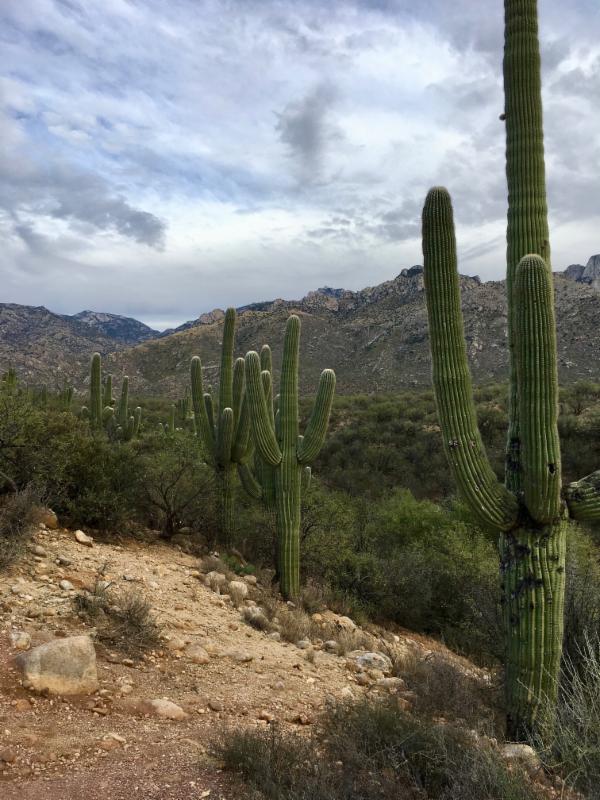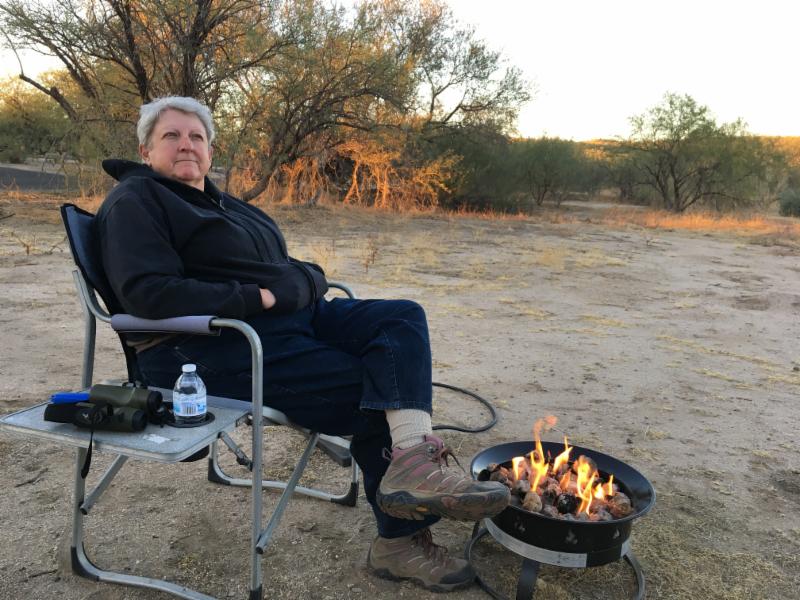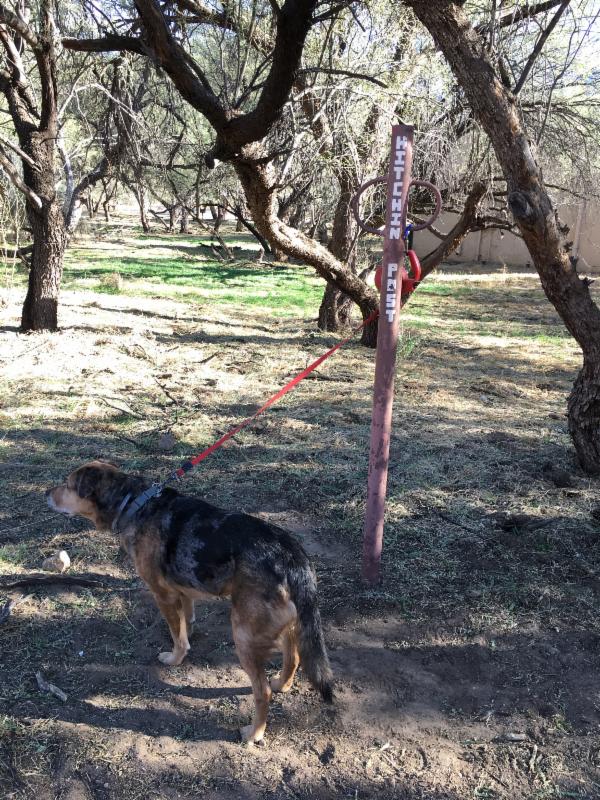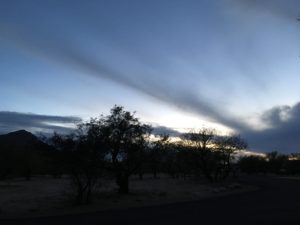Two weeks ago we drove the RV and car down to Tucson for a long weekend. The impetus was an invitation to make red chili tamales with Esther and Jessie, co-hosts with us at Fool Hollow Lake this past summer. Esther makes them every year with her family, and we were invited to learn how.
We drove the easy two and a half hours south on Thursday and pulled into Catalina State Park, set against the back of the majestic Catalina Mountains. It is part of the Sonoran desert, with mesquite trees, cholla cactus, and, of course, the stately saguaros.

Years ago, camping in the desert would have been my last choice of spots, but I was so overwhelmed with being in the Big City that I was actually thrilled to be in the browns and grays and tans of the winter desert.
It was cool, and quiet, with good space between the other campers, and only fifteen minutes from Esther and Jessie’s house. After we leveled and hooked up, Marika hung her bird feeders and Cody and I explored the area behind our camp site. He loved smelling the trail, the ground around the bushes, the coyote poop sprinkled with mesquite seeds.

We all took a sunset walk along the Bridle Trail that skirted the campground through the low desert brush. At one point I was bored with walking and ready to turn around. Marika took out her iPhone and said she didn’t even have a mile yet. I had 1.2, but said OK, and kept going.
And then I fell into the rhythm of my steps, feeling the crunching dirt under my hiking boots that I haven’t worn since last winter. I started looking up as I walked, noticing the jagged edges of the mesquite leaves, and the way the sun lit up the soft white crowns of the saguaros.
And I was suddenly and completely grateful to be taking each step, back to health, and lightness and mobility, and knowing that SOON, we would be on the road, back to living in nature.
We walked to the end of the trail, where it connected with a second trail and the Equestrian Center. There were no horses, but it smelled like hay and manure. We looked in the barn for owls, but didn’t see any.
That night Marika took out her propane fire pit for the first time since the summer, and the three of us sat out until it got too cold, even with a hoodie on. We slept with the windows closed, and it was still cold enough to tuck in under my blanket for a good, deep sleep.

We drove to Esther’s on Friday morning for a delicious veggie quiche and black beans breakfast, then Marika stayed to learn how to make the chili meat. She and Esther seasoned and cooked and cooled more than fifty pounds of chuck roast and ground roast.
Meanwhile, Cody and I settled into camping. We walked the Bridle Trail in the opposite direction, to the picnic areas. We stepped aside for a pair of horse riders on the trail, and Cody wagged his tail as they passed.

We sat outside at our camp site in the shade of the mesquite trees, and Cody napped while I read. I watched the Gila Woodpecker poke his beak into the hummingbird feeder, and studied how the roadrunner sprints about ten feet, then stops, lowers his tail and spreads it wide, waits a few moments before sprinting again, then stopping with the tail spread, and waiting again.
I was truly living my mantra for the weekend: to move and stretch, but not exert, to rest, and read and relax.
On Saturday morning, Marika and I stopped at a local farmers’ market, talked with a gal about nearby archaeological ruins, then I dropped Marika off at Esther’s so they could cut the chilled meat into perfect bite-sized cubes. Esther does not like when the meat is shredded, because it’s not a clean bite. They also made the gallons of spicy red chili sauce, then added the meat to the sauce to cook together and then marinate overnight.

Jessie drove Marika home around four, and we went out to eat at a nearby Chinese restaurant. We took a short evening walk around the campground, then sat outside with the propane fire and watched the dark sky fill with stars.
On Sunday, they picked Marika up at 7am and drove to the south side of Tucson, the Hispanic part of town, for the fresh masa, and a stop at Estrella Bakery for all kinds of Mexican sweet breads and cookies for the grandkids.
Esther’s kids and grandkids arrived around 9. While they ate sweet treats and watched TV, Esther’s youngest son and oldest grandson took turns mixing the dry corn flour with the silky lard that Esther’s oldest daughter, Esther Junior, had whipped in the mixer. The guys used their hands to get the perfect, not dry, not sticky, consistency. Then Esther covered the bowls of mixed masa with damp paper towels so it could rest and rise to a creamy spreadable tamale batter.

Around 11, all of the ingredients were ready, so I drove over to participate in the actual tamale making. I was expecting a lot of helpers and an assembly line, but Esther’s grandkids were more interested in their phones and playing tag than continuing the tamale traditions. And so, after a quick demonstration by Esther, it was just me and Marika and two of Esther’s long-time, tamale-making friends, Sandy and Rosa, each assembling our own tamales.

Spreading the masa is the most critical and challenging part of making a tamale. The batter is creamy and thick, like the consistency of hummus, and you have to spread it evenly across the softened but still-firm corn husks. Not to the edge, not too thick, and without getting it all over you. After I did a few dozen, I asked Sandy if she would do the spreading and then I would do the rest of the assembly.
And so, after she spread the masa on the corn husk, I scooped a large spoonful of the perfectly cubed red chili beef onto one edge of the spread batter the masa, topped it with the required strip of pickled jalapeño and a salted olive (with the pit), then rolled it tight, but not too tight, and folded the husk in half like a pocket.
Together, we made fifteen dozen tamales. Esther steamed the first two dozen, and then we all stopped to eat. The kids gathered and we filled our plates with the spicy tamales, refried beans, and homemade pico de gallo.
After the counters were cleaned off, Marika and the gals got back to work. I sat at the table, watching the production, listening to the buzz of conversations, feeling content and done.
I drove back to camp around two and took Cody for a long walk, then we sat outside, reading. Marika texted me around six that she was enjoying watching football with Jessie, and that she would be home late. I was thrilled that she was finally relaxing.
After two months of clients and appointments and cataracts and RV repairs, I was tired. And cranky. And feeling so done with being in the Big City. Having this time out in the desert, walking, reading, watching roadrunners, smelling the stinkweed and creosote, and feeling the dust in my socks from the trails, was exactly what I needed.

And I knew Marika needed it too. Even though she loved every minute of the tamale making, she was even more tired than when we had arrived. And so I texted her back, asking if she wanted to stay an extra day, so that she could have a day of ease and walking and sitting and watching the birds. And she said Yes.
We had to change camp sites on Monday morning, so we stopped at the dump station so we wouldn’t have to do it the following day on our way out. The new spot was in the center section of the campground with fewer trees, but we had a new view of the mountains, and more room to play ball with Cody. We took some good family walks, enjoyed tamales and leftover Chinese food, and we both felt recharged and ready to return for the last few weeks in the city. More than anything, it reminded us both how much we love to be out in the world of nature.
We all need a break from the bustle and busy of life. If you can’t get away for a long weekend, spending even a single afternoon in nature can calm your nervous system, help you reground and regroup and recharge, and reconnect you with your heart. I highly recommend it!

